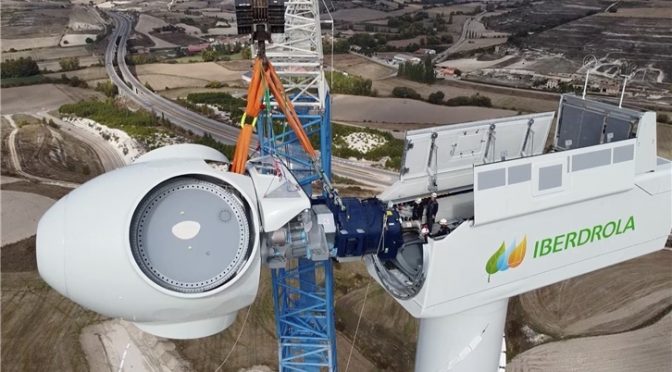The company allocates an investment of 70 million euros to the promotion of the Herrera wind complex, in Castilla y León. The assembly of the 14 wind turbines that make up the wind energy complex begins, with a unit power of 4.5 MW, almost seven times higher than those installed more than twenty years ago The blades have a length of more than 70 meters and the height of the wind turbine is double that of the Cathedral of Burgos Dynamization of the industrial fabric of the region: local companies intervene in civil works and most of the wind turbine components are manufactured in Spain · Its development will involve 800 professionals
Iberdrola has begun the installation of the largest and most powerful onshore wind turbines in Spain, at the Herrera wind farm with a capacity of 63 MW, in Castilla y León. Wind turbines have a unit power of 4.5 MW, almost seven times higher than that of the first wind turbines installed in our country more than two decades ago.
The Herrera Complex, with 63 MW of installed power, will be made up of three wind farms – La Huesa, Valdesantos and Orbaneja – and a total of 14 SG 4.5-145 wind turbines, with blades of 70 meters in length and a diameter of 145 m – three times greater than that of the first wind turbines-, which makes its total height double that of the Burgos Cathedral.
Iberdrola will allocate 70 million euros of investment to promoting the wind complex, which is already helping to boost the industrial fabric of the region. Its development will allow the generation of employment for about 800 people and practically all the work in the field and civil works are carried out by local companies, such as the Burgos construction company Copsa. Furthermore, most of the components of these wind turbines are manufactured in Spain: the multipliers, in Burgos; the nacelles, in Soria, and the generators, in Cantabria.
The size of these components is making their construction a complex process, with up to about 100 daily transports of up to 76 meters in length with different materials and cranes of 180 meters in height for lifting components that in some cases exceed 155 tons. .
The Orbaneja and La Huesa wind farms are being built in the municipalities of Isar, Las Quintanillas, Rabé de las Calzadas and Estepar: the first of them will be made up of seven wind turbines, up to a total of 31.5 MW of installed power; while the second will have four turbines that will add 18 MW. Valdesantos is being built in Estepar and will have three wind turbines with a total installed capacity of 13.5 MW.
The Herrera Complex will be operational in 2021 and, then, will generate energy to supply an equivalent population of 60,000 homes per year, while avoiding the emission into the atmosphere of 50,000 t CO2 / year.
Green bet for Castilla y León
Iberdrola continues to advance in its commitment to clean energy in Spain, incorporating cutting-edge technologies to provide more competitiveness and sustainability to its renewable projects.
With this project, the company reinforces its commitment to Castilla y León and its leadership in renewable energies in the region, where it already operates more than 5,100 MW – of which 1,500 MW are wind power -, placing it as the autonomous community with the most green megawatts ‘installed by the company.
Together with the Herrera Complex, Iberdrola is also promoting the Buniel wind complex in Burgos, in collaboration with Caja Rural de Soria, and the Valdemoro park, with a total of 164 MW, which make it one of the largest in Castilla y León. Last year the BaCa (Ballestas and Casetona) wind complex, of 69.3 MW, was put into operation and is progressing in the processing of its first photovoltaic projects in the region, totaling more than 400 MW.
Iberdrola announced a few months ago that it will promote in the community in the coming years more than 1,800 MW in renewable projects -eolian and photovoltaic-, for which it will allocate investments of more than 1,300 million euros. This volume of resources will invigorate the industrial fabric and will generate employment for 18,000 people, according to the estimates established in the PNIEC.


